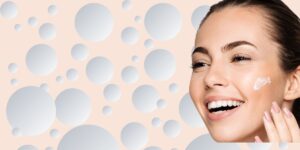Introduction
Polyhydroxy acids(PHAs), such as Lactobionic Acid, represent the next generation of hydroxy-acids. They provide clinically proven anti-aging and skin-smoothing effects that are comparable to AHAs, while offering several advantages 1. Importantly, they are less irritating compared to AHA’s and cause less stinging and burning2. Therefore they are compatible with sensitive skin types.
Because of their chemical structure, PHA’s have a number of added skincare benefits not provided by AHA’s. Their polyhydroxy structure means that these compounds enhance the skin barrier, act as humectants and moisturisers and have antioxidant effects
Benefits for Your Skin
“The polyhydroxy acids (PHAs) and polyhydroxy bionic acids (bionics) represent the next generation of alpha hydroxy acids (AHAs) in cosmetic and dermatologic skin care”1
The skin benefits provided by Lactibionic Acid treatment are well established and well supported by research2. Lactobionic Acid offers the following skincare benefits:
1. Dry Skin Treatment
Treatment of dry skin conditions with Lactobionic acid restores the startum corneum and the epidermis to a more normal clinical and healthy state2. The hydroscopic nature of Lactobionic Acid makes it a strong mositurising agent for treatment of dry skin3,4.
2. Sensitive Skin and Rosacea
PHAs such as Lactobionic Acid are more compatible with sensitive skin types than AHAs as they are more gentle of the skin.
3. Hyperpigmentation Treatment
With sustained treatment by Hydroxy Acids, lightening and even complete fading of hyperpigmentation can be achieved.
4. Anti-aging, Photoaging Treatment
Antiaging benefits of reduced wrinkles and fine lines can be achieved with the daily application of PHAs to the skin5. This can result in increase in dermal thickness and firmness that persists after application ceases. Hydroxy acids increase skin production of collagen and hyaluronic acid which result in thicker and firmer skin.
5. Enhance Skin Barrier Function
The Stratum Corneum is the thin outer layer of cells that protect the skin from attack by environmental factors. HydroxAcids can enhance the skin barrier function by increasing ceramides within the stratum corneum6. Lactobionic Acid reduces the skin pH without irritation and enhances the skin barrier function4.
6. Acne and Acne Scar Treatment
Lactobionic Acid has similar acne treating properties to other AHAs7 but is better suited to treatment of people with sensitive skin types.
7. Antioxidant Action
Polyhydroxy acids (PHAs) such as lactobionic acid are also antioxidants and can be combined other active ingredients for added benefits6.
Discussion
“Lactobionic acid has numerous beneficial properties as a result of its polyhydroxy bionic AHA structure, making it ideal for use in skin care. It is a moisturiser and an antioxidant and is nonirritating to skin”8
Because of its many benefits and nonirritating action, Lactobionic Acid has been described as the new superacid in skincare. It’s unique structure provides hydroxy acid benefits without irritation. However, it also provides strong humectant, anti-oxidant and skin barrier repair benefits. Our new generation, Green Micelle™ nano-encapsulation technology is well suited for use with Lactobionic Acid.
References
- 1.Green BA, Sabherwal Y. Antiaging Benefit Ingredients: AHAs, BHAs, and Bionic Acids. In: Procedures in Cosmetic Dermatology. 3rd ed. Elsevier; 2016:99-116.
- 2.Green B, Yu R, Van S. Clinical and cosmeceutical uses of hydroxyacids. Clin Dermatol. 2009;27(5):495-501. doi:10.1016/j.clindermatol.2009.06.023
- 3.Tasic-Kostov M, Pavlovic D, Lukic M, Jaksic I, Arsic I, Savic S. Lactobionic acid as antioxidant and moisturizing active in alkyl polyglucoside-based topical emulsions: the colloidal structure, stability and efficacy evaluation. Int J Cosmet Sci. 2012;34(5):424-434. doi:10.1111/j.1468-2494.2012.00732.x
- 4.Tasić-Kostov M, Lukić M, Savić S. A 10% Lactobionic acid-containing moisturizer reduces skin surface pH without irritation-An in vivo/in vitro study. J Cosmet Dermatol. 2019;18(6):1705-1710. doi:10.1111/jocd.12908
- 5.Grimes P, Green B, Wildnauer R, Edison B. The use of polyhydroxy acids (PHAs) in photoaged skin. Cutis. 2004;73(2 Suppl):3-13. https://www.ncbi.nlm.nih.gov/pubmed/15002656
- 6.Edison B, Green B, Wildnauer R, Sigler M. A polyhydroxy acid skin care regimen provides antiaging effects comparable to an alpha-hydroxyacid regimen. Cutis. 2004;73(2 Suppl):14-17. https://www.ncbi.nlm.nih.gov/pubmed/15002657
- 7.Decker A, Graber E. Over-the-counter Acne Treatments: A Review. J Clin Aesthet Dermatol. 2012;5(5):32-40. https://www.ncbi.nlm.nih.gov/pubmed/22808307
- 8.Green B, Edison B, Sigler M. Antiaging Effects of Topical Lactobionic Acid: Results of a Controlled Usage Study. Cosmetic Dermatology. 2008;21(2):76-82.












